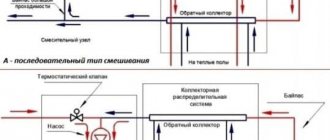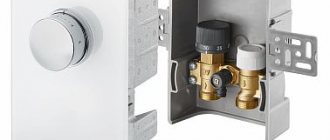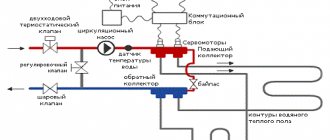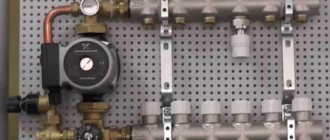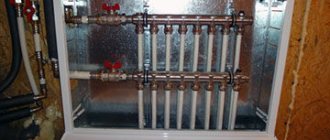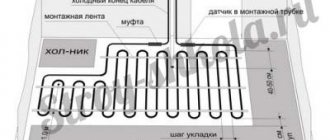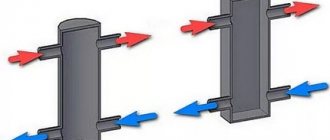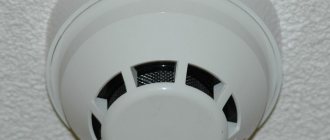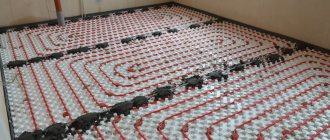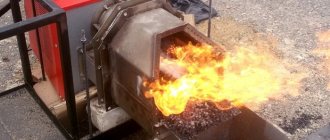What is a servo drive and how it works
A servo drive is a self-contained electrical device that rotates machine parts with high efficiency and great precision. The output shaft of this motor moves to a certain angle, position and speed, which a conventional motor does not have the ability to do. The servo motor uses a regular motor and connects it to a sensor for positioning feedback. The controller is the most important part of the servo motor designed for this purpose.
The element is a closed-loop mechanism that includes position feedback to control rotational or linear speed and position. The motor is controlled by an electrical signal (analog or digital), it determines the amount of movement that represents the final command position for the shaft. The encoder type is determined by the sensor, providing speed and position feedback. This circuit is built directly inside the motor housing, which is usually equipped with a gear system. A servo drive for heated floors from Aliexpress saves time and money, but it is also available in other stores.
The main difference between a servomotor and a motor is that it is controlled by torque, as well as position and speed. Main types of devices:
- asynchronous;
- synchronous;
- direct and alternating current.
Operating principle of servo drive
An electric current passes through the nichrome heating element, causing the expansion of the liquid (toluene) in the bellows. This is precisely the operating principle of the servo drive for heated floors. A servo drive for a heated floor consists of a spring mechanism and a container in which a special liquid is placed. This liquid expands under the influence of temperature and affects the rod, which extends and presses on the thermal valve rod. The valve is automatically closed. Under the influence of voltage, the liquid heats up and expands. That is, this servo drive does not have an electromagnetic motor. The force used comes from the expansion of the liquid due to temperature. Such a drive is called a thermal drive. Therefore, when voltage is applied to the servo drive, the valve closes only after a certain period of time spent warming up the liquid. This time varies from 1 to 3 minutes.
If there is no voltage, the servo will cool down and the valve will return to its original position. Cooling down the device takes much longer than heating it up.
There are servos for heated floors that do not have expansion fluid. The mechanism of such a drive consists of moving the rod due to heating of the compensation thermoelement. A thermocouple is a plate or spring that changes its position when heated.
On top of the servo there is a retractable mechanism, which is necessary for the next one. It determines the fit of the actuator in the thermal valve and shows the valve mode: On/Off.
The servo drive for heated floors has overheating protection and a built-in power shut-off mechanism. These actuators are connected to a manifold thermostatic valve or a separate thermostatic valve.
What types of servos are there and how to choose the appropriate option
AC or DC metering is the simplest motor classification. Looking at it from a performance perspective, the main difference between DC and AC motors is the ability to control speed. In the first case, the speed is directly proportional to the voltage applied with a constant load. And in an AC motor, the speed is determined by the frequency of voltage supply and the number of magnetic poles.
Nowadays AC and DC motors are used in servo drive systems, AC motors can withstand high current voltage and are more often used in embedded components and other industrial applications where high precision is required. The servo drive for heated water floors is in high demand due to its practicality.
The DC motor is connected mechanically to the brushes using a special element, or used without brushes. Motors made using brush technology are more expensive, but they are also easier to operate, maintain and repair. Products without brushes are reliable, have higher efficiency and are less noisy.
A commutator is a rotating electrical switch that periodically reverses the direction of current between the rotor and the drive circuit. It consists of a cylinder as well as several metal contact segments on the rotor. Two or more electrical contacts made of soft conductive material. A servo drive for a warm water floor collector allows you to simplify and automate the presented system.
Types of servo drives for heating
Today, certain servos for underfloor heating are especially common. They are all divided into two categories, differing in their operating principle and functionality. Depending on the design there are:
- closed;
- open.
You can already guess what the operating principle of the first and second options is.
Enclosed servomotors are characterized by an open position without power supply. When a signal is given, the mechanical part is activated and blocks the access of liquid to the system.
Servomotor normally closed for heated floors
Open appliances work the other way around. In a quiet state, the servomotor is in a closed state, and when a signal is given, the mechanical part begins to operate and thereby allows fluid to flow into the pipeline.
Which type of servo drive is more suitable for your system is up to you to decide. You need to adequately assess the capabilities of your heating system, as well as weather conditions.
In most cases, of course, normally open actuators for a warm water floor manifold are purchased.
STOUT - electrothermal compact actuator normally open, 230 V
If the device breaks down, the coolant in the pipeline will continue to circulate and leave the floor warm for a certain time. This is a big plus especially for houses outside the city that are located in an area of frequent cold weather.
In connection with the method of power supply, devices powered by:
- Electricity voltage 24 V (equipped with inverters).
- Connected to 220 V AC mains.
Another type of device is known, but it is used very rarely. These are devices that are set to their normal position based on the technological requirements of the heating system. They are called universal, they can function both in a normally open state and in a normally closed state.
All three servos can be connected to the collector. The main thing is that the settings, balancing and operating conditions are correct.
How to assemble a manifold for a heated floor with your own hands?
Types of servo drives for a warm water floor collector
Depending on the state of the hot water (coolant) at the time of no voltage, a distinction is made between normally open and normally closed servos.
Normally open servo drive - the device ensures the movement of coolant in the normal state. Those. when there is no voltage, the internal valve is in the “Open” state.
A normally closed servo drive is a device in which the normal state of the valve is in the “Closed” mode, therefore, in the absence of voltage, no coolant flows.
There is another option for devices in which the normal position can be set depending on the requirements of the system. A universal, switchable electric floor heating drive allows you to change the state “Normally open” to “Normally closed”.
Fundamental differences and recommendations for use in different types of servos
Servo drives for heated water floors come in 2 types:
- Normally open. Initially, the tap he controls will be open. If there is no power to the drive, the coolant circulates freely through the device;
- Normally closed. Accordingly, the tap will initially be closed. There is no power - the coolant does not pass through it.
There are servos where you can select a default position. They are called universal or switchable. When choosing a specific type, you need to know in which position the crane needs to be most of the time. If the coolant circulation is assumed to be constant, it is recommended to choose a normally open type of device.
If your region experiences prolonged frosts, you should only select a normally open type of servo drive. Since in the absence or failure of the power supply, as well as in the event of a breakdown of the drive, the circulation of the coolant will not be disrupted and the floor will be hot as long as hot water is supplied from the boiler.
Normally closed devices are used in regions with mild climates, where stopping the supply of coolant to the system will not have negative consequences. Among the models of both types there are servo drives with smooth adjustment. It is recommended to use them when the project requires quantitative dosing of the coolant supply.
Varieties
There are the following types of mechanisms for adjusting the temperature of a warm water floor:
- Normally open. The valve is in the default open state if there is no voltage. In this model, the coolant can freely pass through the valve;
- Normally closed. In this option, the valve is in the closed state by default. If there is no voltage, the coolant does not enter the system;
- Universal. These models can switch to one of the modes where the valve will be in a closed or open state.
Normally open servo
Servo drive Watts 22CX normally closed 220V
Universal
What determines the choice of servo drive type?
When deciding to purchase a servomotor for a heated floor, you need to consider what position the valve should be in most of the time. If the coolant must constantly circulate, choose normally open. Under conditions of long, cold winters, precisely such mechanisms are installed. Another advantage of a normally open servo drive is that in the event of power outages, or if the device itself fails, the floor heating system will be supplied with hot water.
10 servos on the distribution manifold.
A normally closed servo drive can be used in regions with warm climates, so this type is used less frequently in Russia.
Attention! Among servos, there are devices with smooth adjustment. Such mechanisms are equipped with an electronic regulator that provides the required voltage. Depending on the voltage, the movement of the rod, which exerts pressure on the valve, is more accurately regulated. This type of drive is used where it is necessary to smoothly dose the volume of passing coolant. But they are practically not used in underfloor heating systems. When purchasing a thermal drive, pay attention: does it require installation of an electronic regulator? If it is necessary, you are dealing with a thermo-ELECTRONIC drive, the use of which in underfloor heating systems is impractical.
Types of servo drives for heated floors
The servo drive for heated floors can be normally open or normally closed.
Let's look at each type in detail:
Normally open means the valve is open by default. That is, if there is no voltage to the servo drive, it is in the “Open valve” position. This option involves the passage of coolant through an open valve.
Normally Closed – The valve is closed by default. In this case, in the absence of voltage, the coolant cannot pass through the closed valve.
There are servos that switch to one of the positions: normally open and normally closed. Such drives are called universal switching servos.
Operating principle of a normally open servo drive (without an electromagnetic motor)
The servo drive device for the underfloor heating manifold is quite simple. In the central part of the body there is a spring mechanism and an internal small container (cylinder) filled with a special liquid (most often toluene).
A nichrome heating element is placed around the container. In operating mode, when electric current is supplied, the heating element heats the liquid, this liquid increases in volume and expands. The pressure on the rod increases. This part of the device extends, presses on the thermovalve rod, which closes accordingly. As soon as the voltage disappears, the heating element stops working, the liquid gradually begins to lose temperature and loses volume. In the end, it takes on the original volume, stops putting pressure on the rod and the valve opens.
3 drives on the distribution manifold of the heated floor.
Thus, the movement of the valve, its opening and closing, occurs without an electromagnetic motor, due to the pressure of the heated liquid in the cylinder (in the internal container). Therefore, this mechanism is rightly called a thermal drive.
It takes time for the valve to move. Heating of the liquid takes about 2-3 minutes, therefore, the valve does not close immediately after applying electric current. The heating time of the liquid depends on the characteristics of the heating element and is indicated in the technical specifications by the manufacturer. Cooling occurs a little slower, so the reverse process of opening the valve takes longer (5-15 minutes).
In case of overheating, a power shutdown mechanism is activated.
Note! There are servos for a warm water floor collector that do not contain a liquid cylinder. Its role is replaced by a special thermoelement, which is a plate or spring that expands as a result of heating. The principle of operation of the expanded thermoelement is no different from the process described above. When the thermoelement heats up or cools down, the rod moves the valve.
Externally, you can determine the position of the valve by a retractable element (resembling a button).
Position of the “button” in the heated and cooled state.
If its position is different, this is a signal that the servo drive is connected incorrectly.
The position of the valve can also be checked after touching the mechanism - if it is hot, the valve is in the “Off” mode, if it is cool, the valve is open.
Servo drive and its varieties
The servo drive regulates the flow of water into the system
. As mentioned above, the servo drive is an additional equipment that is installed on the distribution manifold for a warm water floor.
The device is used to regulate the flow of water entering the heating elements. This process is carried out by opening and closing control valves, which are located on the return comb of the manifold.
Mechanical servo drive
This device is the simplest version.
A mechanical servo drive is the simplest version of this device.
It has a simple design and reasonable cost.
The temperature is adjusted directly on the device itself by rotating a special wheel that decreases or increases the temperature.
There is no need to control the device itself; the main thing is to set the required value, and a servo drive of this type will control the temperature.
Mechanical devices are not combined with a temperature sensor.
Such a device is not coordinated with a temperature sensor and cannot automatically operate (turn on and off) when the temperature of the heated floor increases and decreases from a given setting.
The device requires constant monitoring of the temperature when leaving home and even before going to bed, but its service life is very long and the device does not require preventative settings or additional maintenance.
Electronic servo drive for manifold
The electronic device receives information from a temperature sensor.
The electronic version of the heated water floor servo drive is also a fairly simple device that is capable of automatically adjusting the supply of coolant to the heating circuit of the system.
Servo-drive commutator circuit
The device is in constant electronic coordination with the thermostat, which is the brain center. The thermostat or thermostat is coordinated with a temperature sensor, which is installed near the heating elements in the heated floor screed.
Accordingly, the temperature limits at which the servo drive will open and close the adjustable valve to supply hot water to the heating circuits are set on the thermostat. One of the options for connecting a thermostat to servos can be seen in the table diagram.
An electronic type device is capable of completely independently producing and controlling the supply of coolant to the heating system, but in order to purchase it, each owner will have to shell out a considerable amount of money.
It should be remembered that when choosing an electronic servo drive, it is necessary to take into account the characteristics of the room itself, or rather the power supply area. You should also pay attention to how often power outages occur.
If they happen often, then you should additionally install a UPS (individual power supply) or opt for a mechanical device for regulating the coolant supply. For more information about servos, watch this video:
Classification of devices by control method
The servo drive models on the market can be divided into 3 groups, depending on the control method:
- Mechanical . The main advantages are its low price and high reliability. The user does not require special knowledge to operate it. This is a primitive device that regulates the flow of coolant; constant monitoring is not needed. The disadvantage is the impossibility of programming and manual configuration - this can take a lot of time.
- Electronic . This servo drive has advanced functionality. The electronic display can display system operation, temperature, and the presence or absence of breakdowns. The advantages are the convenience of regulating the system temperature and the ability to operate in automatic mode. The downside is the high price.
- With remote control . Such servos allow you to make any settings, even ignoring the manifold for the heated floor. The system is capable of operating even in the absence of a person. It is desirable that the collector unit consists of elements from the same manufacturer. The disadvantage is also the high price.
Servo drives are installed on thermostatic valves located on the manifold or on free-standing valves. They must have a shutdown mechanism and overheat protection.
Types of servo drives for heating system
Several types of servo drives can be used in heating systems. The most common of them are mechanical devices. They differ from similar devices in their simplicity of design, affordable price and reliability in operation. The user can adjust the temperature by rotating the wheel on the servo drive housing. Thus, you can increase or decrease the temperature indicator.
Mechanical servos are not combined with temperature sensors. Due to this, they are not able to function in automatic mode - turning on or off independently when the temperature deviates from the set level. Therefore, the operation of mechanical devices must be checked regularly, for example before leaving home or work. Also, mechanical devices do not have the ability to set a minimum temperature threshold.
Electronic servo drives regulate the temperature automatically and do not require control. The servo drive provides precise control of the volume of coolant supplied to the heating circuits. The electronic device is capable of working in conjunction with a thermostat. Using a thermostat, temperature thresholds are set. If there is a deviation from the set levels, the servo drive will automatically control the valve, closing or opening it.
Electronic servos are equipped with a display for easy operation control. Servo drives with remote control are also available on the domestic market. The operation of such devices can be controlled while being away from the collector. Wireless servos are equipped with two sensors that are designed to control room temperature. Remote-type devices can operate in several modes. In most cases, wireless models are equipped with overheating protection.
Servo drives come in two types - normally closed and normally open. In the first option, the open valve is the starting position. In the second case, the valve is closed. Normally open servos are designed for regions with long winters and severe frosts. In the absence of electrical voltage, the valve position will always be fixed open. This eliminates the risk that the house will stop heating during power outages.
The range also includes universal devices that are capable of quickly switching open and closed positions.
Recommendations for selecting devices
Having studied the assortment presented on the market, it is recommended to opt for manufacturers that have already proven themselves in terms of quality and convenience. As an example, a servo drive from the Valtek brand. This manufacturer has adjusted the entire range of products to our “realities”. This guarantees high-quality collaboration of individual elements. Models from this manufacturer have a wide range of functions and are affordable.
The choice also depends on compatibility with temperature sensors and taps used in the system.
Using special thermal heads
The thermostatic head is a device filled with a special composition. Thermal heads should be installed simultaneously with a three-way valve, without which it will be simply impossible to regulate the temperature of the radiator.
Thermostatic head is a modern and not too complicated way to automatically regulate the temperature of heating radiators. These devices should be installed on a three-way valve
The filler expands quickly when heated and contracts just as quickly when cooled. The expansion or contraction of this composition affects the stem of the three-way valve installed under the thermal head.
The device has a regulator with which you can manually set the coolant temperature required at the moment. In the future, the heating is adjusted automatically. However, if the room temperature changes, the new data on the thermal head will have to be set manually again.
All thermostatic heads can be divided into two types: stationary and remote. The first ones are installed using a valve directly on the radiator pipe. The latter are equipped with a special remote flask, which contains a composition that reacts to changes in temperature. The thermal head itself is mounted near the radiator, and the flask can be placed at some distance. The flask is connected to the thermal head with a special capillary tube.
The remote flask is connected to the thermal head by a relatively short capillary tube. The flask should be installed in such a place that the temperature measurement is as correct as possible
Typically thermal heads with a remote bulb have a fairly short capillary tube, so the options for placement of the bulb will be quite limited.
Distribution manifold and its purpose
Such a collector is mounted for distribution and control of coolant in various heating systems, in particular, in warm water floors. It is almost always installed in conjunction with a pump that pumps water through the system. The manifold looks like a pipe on which there are inlets/outlets for connecting various pipelines. Their number, size and location depend on the design of the heating system. There are threads on both sides of any manifold, external or internal. It is designed for two or more independent circuits.
Depending on the function it performs, the collector can be:
- supply - usually it is the top one, the coolant comes from the boiler into it and is distributed along the different contours of the heated floor;
- the return one is located below, the cooled coolant comes into it from the heated floor loops and is directed to the boiler, which will heat it and return it to the system through the supply manifold.
This ensures uniform coolant circulation.
On the video : the purpose of the servo drive.
Water floor servos
Automatic control of the temperature of a warm water floor is impossible without the presence of servos. These are small electro-thermal devices that open/close the coolant supply. They are also called servomotors, and the official name is “electrothermal servodrive”. In principle, the same devices can be installed on radiators, but this is not done often.
This is how the servos look “live” on the commutator
How do servos work? The main working element is the bellows. This is a small sealed and elastic cylinder, which is filled with a substance, the volume of which strongly depends on temperature. There is an electric heating element around the bellows. When a command is received from the thermostat, power appears on the heating element. It starts working, the substance inside the bellows heats up and begins to expand. The enlarged cylinder presses on the rod located below. And it, in turn, blocks the flow of coolant. As you can see, no motors or gears, only electricity and thermal energy. That is why they are called thermoelectric.
Servo drive - appearance and internal structure
A little about the varieties. There are servos that are normally closed and normally open. These names show what position the valve is in when there is no power: the first is open in the normal position, and closes when a signal appears; the second, accordingly, is closed in the normal state, and opens when a signal is present.
Which one is better to use? For our country, it is better to give preference to normally open servos. And here's why: if it fails, the coolant will continue to circulate and the floor will not freeze (although long and low temperatures are needed for the pipes in the screed to freeze).
There are also devices that operate on 220 V AC or 24 V DC. To supply 24 V voltage, you will need to install an inverter.
How to connect servos
The connection diagram may be different and depends primarily on the type of thermostat. If thermostats control one circuit of a heated floor, then they are directly connected to the corresponding servos by wires. If the thermostat is multi-zone, then the wires are connected to the corresponding terminals.
One of the switching units for water heated floors
Heated floor switches are used to organize wires. In addition to the standard function of connecting and connecting different devices, they also perform a protective role. When all circuits of the water floor are closed, a signal is sent to turn off the circulation pump. This is convenient if automated heating boilers are installed (the pump will not run idle without flow, and the system will not fail due to excess pressure).
How to connect devices through a water floor switching unit
But in systems with conventional solid fuel boilers, the pumps cannot be turned off: the boiler will not go out and turning off the pump threatens to rupture the system. In this case, install a bypass and a bypass valve (see connection diagram). The bypass valve is set to a pressure slightly lower than the maximum pressure of the pump (if it has a maximum of 5 meters, set it to 3-4 meters). When this value is reached in the system (this happens if a small number of underfloor heating circuits remain open), the bypass valve begins to turn part of the coolant flow into the “return” and feed it back to the boiler.
Switching circuit with a bypass valve to prevent the system from running dry
This scheme will work with any type of boiler, not only solid fuel. But for them, it is practically the only inexpensive way to protect the system from overheating.
Advantages of using automation systems for heated floors:
- After installing the heated floor control units, their operating mode is optimized taking into account the parameters specified by the user
- Direct savings in energy resources, since without automation, heating devices operate continuously, which is not always required by their owner
- Protection of floor coverings is provided, since they do not withstand significant temperature changes and can simply crack. Automation allows you to set the upper temperature limit and thereby prevent deformation of finishing materials.
- Provides comfortable control and monitoring of floor heating parameters. Automatic underfloor heating allows you to set the required temperature once and not interfere with the operation of the equipment in the future. And with the help of wireless control of a heated floor, monitoring the operation of the heating system and changing its settings become available even from mobile devices - remotely via the Internet. To do this, you just need to install a special application from the manufacturer and register on its website.
Popular manufacturers of servo drives for water heated floors
You can purchase servomotors in different ways, such as: the Internet, building stores, or the market. They are produced by different manufacturers and have their own characteristics. According to consumer reviews, the best companies are considered.
"VALTEC"
This company employs highly qualified Russian and Italian employees to produce basic heating systems and their additional equipment. The best servos produced by them are:
- A. – These servos are of the “normally” open type. They are produced in mechanical models and have the following characteristics: connecting size - M 30 x 15; power – 2 W; conductor cross-section – 0.75 sq. mm.
- 0. – this device is produced “normally” closed with an on-screen display. . The actuator is designed with toluene, making it suitable for three-way valves.
- 0. – this device operates due to the liquid in the bellows. Available in “normally” open form. The work is done through the supplied adapter. Product power – 1.8 W, conductor cross-section – 0.75 sq. mm.
VALTEC
"Watts"
"Watts" is considered one of the leading companies in the production of additional thermoelements for heated floors. The distinctive feature of the company is the quality of its products at an affordable price. The following are considered effective series of servo drives from these manufacturers:
- 22C. — this equipment for temperature control is installed on a return coolant. They are produced in a “normally” open and closed form. The power of the product is 2.5 W.
- 22СХ. — these devices are produced in “normally” open and closed forms, electric models. The level of electricity consumption is 1.8 W, operating temperature is 100 – 110 °C.
- — servos of this series for the collector are available with an LED indicator. Thanks to it, you can track the process of equipment operation. When there is electricity, the color is green, and when there is no electricity, blue.
Watts
"Rehau"
Servomotors from this German company are considered the best additional equipment for heated floors. Recommended, innovative series are considered:
- UNI for 230.24 V. Using an adapter, servos of this series are attached to the commutator . Visual monitoring of system operation is carried out through a built-in indicator. Cable cross-section - 0.5 sq. mm.
- UNI 230, 24. This servo drive is produced with a built-in monitor, in a “normally” closed form. The product is attached to both the supply and return coolant.
Rehau
Having examined the types of servomotors and familiarized yourself with their operating principles, you can independently verify that their use increases the functionality of the water system. The devices are reliable, have full temperature control and are easy to use. Having performed the correct installation, servo drives for a heated water floor collector can last quite a long time, which will allow saving on the family budget in the desired microclimate.
AdminAuthor of the article
Did you like the article?
Share with your friends:
Types and types of sensors
Remote electric floor temperature control sensor
All sensors and regulators can be divided into two types:
- The mechanical device has an operating principle based on the property of changing volume depending on temperature readings.
- Electronic, installed remote sensor in the form of a thermistor. It is supplemented by a separate control unit containing an electronic circuit, operating order and indication elements.
Devices are also divided by type:
- a device operating in economy mode, which allows you to reduce the level of floor heating in the room when there are no people;
- sensors with a timer, which have a program for turning on/off the heating system;
- intelligent sensors with a built-in operating algorithm and control of other factors: humidity conditions, temperature fluctuations outside the room, presence/absence of people in the room, etc.;
- limiters are thermal devices that turn off the heating of the coolant when a predetermined temperature is reached.
Advice! In simple heating systems, the presence of highly intelligent sensors is less justified than connecting a conventional electronic regulator. Numerous functions of the devices will not be in demand, for example, in warm water floors.
Example of a mechanical sensor with a temperature element
Thermostats for water heated floors differ in the type of monitored environment:
- floor temperature control;
- control of the degree of air heating.
As a rule, sensors for determining air temperature are located in the thermostat housing. This provides additional convenience, since no unnecessary installation problems are foreseen; on the other hand, the installation of the thermostat must meet a number of conditions:
- absence of nearby sources of heat/cold;
- There is no threat of direct sunlight or draft blowing.
Important! The installation location of the device is selected taking into account the accuracy of the temperature display, so it is best to place the equipment at a height of at least 1-1.5 m from the floor.
The water floor system can be supplemented with a remote temperature sensor. Representing a small-format device attached to the end of a long cable, the measuring device is mounted in the floor with a distance of 0.5 meters from the wall. The placement is shown at a distance equidistant from the nearest coolant pipes. The second end of the structure is connected to a temperature sensor and attached to the terminals according to the diagram.
Where are the most expensive new buildings in the Moscow region?
Advice! This type of device must be installed during pipe laying before pouring the concrete mixture. It happens that such devices fail, so it would be useful to provide for the possibility of replacement by laying a corrugated hose.
Device classification
So, the servo drive can be divided into the following types:
- Mechanical. It is quite simple to operate, as it has a simple device. The main advantage of the presented product is its low cost and durability. To regulate the temperature, simply turn the wheel on the dashboard slightly to increase or decrease the indicator. In this case, there is no need to constantly monitor the operation of the device, since further operation occurs automatically. The only drawback of a mechanical servo drive, which is intended for water heated floors, is that it is not possible to program the minimum temperature value. Therefore, manual configuration may take some time. If you need to leave home for a long time, you will need to set the required temperature value manually.
Servo drives for water floor manifold
- Electronic. This servo drive has wide functionality. Thanks to the electronic display, you can see how correctly the water heated floor system is working and whether there are any malfunctions. In addition, the presented device has the same simple structure as the mechanical version. However, it is much more convenient to use. The temperature of the water heated floor is adjusted automatically, without human intervention. However, its use has a significant drawback: quite high cost.
Servi drives installed on the manifold
- Remote. The main advantage of the presented device is that all the necessary settings can be made without being near the collector. That is, the remote servo drive has 2 sensors that can very accurately monitor the temperature difference in the room. Moreover, such a device is capable of functioning in approximately 9 different modes. Therefore, the device makes it possible to strictly monitor how much electrical energy is consumed. The main requirement for such a servo drive is that it is better to install on the collector the device that comes complete with the water heated floor system. That is, the manufacturer must be the same.
In addition, it is possible to distinguish between closed and normally open devices. If we take the first case, then the valve is closed by default, so even when voltage is applied, the coolant will not pass through it. As for the normally open servomotor, heated water passes through it without obstacles.
Connection diagram for a heated water floor thermostat
Connection diagram of thermostats to a manifold with a servomotor
This design does not require the installation of a device, such as electric floors. In the case when the boiler is not powered by electricity, there will be no large financial costs with little optimization of heating operation.
There is an option for adjustment in the usual manual way, based on subjective preferences, but only if the floor is the only heating device and the boiler does not raise the temperature above +50 degrees. But if there are other heaters in the house (in the system): radiators, a hot water circuit, a thermostat for a water floor, installation is required.
The simplest connection diagram is to install a thermostatic head with a remote-type sensor on a two-way valve. In this case, the head filled with a heat-sensitive substance will instantly respond to any changes: when heated, the substance will expand, and when cooled, it will contract, thereby opening or closing the coolant supply.
Advice! For a large house with several branches of the heating system, it is preferable to install several temperature sensors with servo drives.
Connection diagram for a thermostat for a water floor:
- the servo drive is mounted on the return comb of the manifold for a warm water floor;
- wires are pulled from the collector to the regulator device, equipped with an air temperature indicator;
- the distributor box for the drive and thermostat is located in the manifold cabinet at a level above the combs;
- the cable from the distribution box goes to the distribution panel.
Electric servomotor to regulate the temperature of the water floor
What are water floor servos? These are devices without which it is not possible to regulate the temperature of the liquid water coolant. Representing small-format electrothermal devices that open/close the media supply, servos operate through a bellows - a cylinder filled with a substance that has the ability to change volume under the influence of temperature.
Today, manufacturers offer two types of servos: open and closed. Valve Position Difference:
- in open designs the valve is open until the heating/cooling signal appears (at which it closes),
- in closed - the valve is normally closed until a signal appears at which it opens.
The choice depends on the user’s preferences, however, experts recommend open-type servomotors due to the fact that even in the event of a breakdown, the water in the system will continue to function and the floors will not freeze.
Electric and water heated floors: scope, design diagrams and calculations
Important! When choosing servos with a 24V DC voltage supply, you will need to install an inverter.
Connecting the servo drive is not difficult. Depending on the type of thermostat, it is possible to connect:
- if there is a thermostat that controls a single floor heating circuit, installation is carried out with the appropriate wires;
- if the device is multi-zone type, the wires are connected to the corresponding terminals.
Thus, servo drives perform not only the role of passing/closing the coolant, but also a protective function. The closed position signals the end of pump operation, which will extend the life of all equipment - the pump will not run idle, which means the risk of system failure due to increased pressure will be minimized.
Important! In underfloor heating systems, the pumps of which are of the usual solid fuel type, turning off the pump is unacceptable: the boiler will not go out anyway, and stopping the functioning of the system (signaling) threatens to rupture the entire structure. Installing a bypass and bypass valve will avoid this situation.
Operating principle and design of a water floor servo drive
Any servo drive that is used for heated water floor systems has the following device: a spring mechanism and a container (bellows) containing a special liquid - toluene. Under the influence of temperature, the substance presented is capable of expanding and putting pressure on the thermal valve rod, which, in turn, extends. In this case, the valve closes.
After the liquid inside the servo has cooled, the valve returns to its original position. The device cools down much longer than it warms up. It should be noted that there are devices that operate without toluene. In this case, the rod moves due to heating of the compensation thermal element. It is presented in the form of a spring or plate, capable of changing its location due to heating.
At the top of the servo actuator you can see a special retractable mechanism, which not only determines how the thermal actuator is seated in the valve, but can also indicate the operating mode of the valve (whether it is turned on or not).
Indication of the valve position on the servomotor and its structure: 1- Nut; 2 - Spring; 3 - Bellows; 4 — Housing with LEDs; 5 - Auxiliary contact; 6 - Cable
Another servo drive, which is installed on a heated water floor system, has special protection against overheating. That is, if the permissible temperature is exceeded, thanks to the built-in power-off mechanism, the device stops working. Such devices can be connected either to a separate thermostatic valve or to a manifold valve.
Depending on the technical parameters of the room in which the water heated floor will be equipped, you can use a servo drive operating on alternating or direct current. Dmitry Shumakov will tell you more about his work in the video:
Methods for automatically controlling water heated floors
Controlling a circulation pump is the easiest way to regulate the temperature of a water-heated floor, perfect for rooms where there are several pumps. They turn on or off depending on the room temperature measured by the room thermostat. If one common circulator is installed in the heating system, then this method is not suitable, since the heating will be turned off or on in the entire house at once, and not just in the desired room. Control using a thermal head is a semi-automatic control system that allows you to regulate the heating temperature under certain conditions. A thermal head with a sensor installed on it is mounted on a mixing unit with a three-way valve and measures the temperature of the water in the system. For example, the thermal head closes the three-way valve if the temperature of the coolant in the pipes exceeds the set one and, conversely, the thermal head slightly opens the three-way valve of the hot water pipe as soon as the temperature drops below the set one. Servo drive control . In this case, servo drives are mounted on the underfloor heating manifold, with the help of which the supply of coolant to different heating circuits is regulated. Depending on the data from underfloor heating temperature sensors or thermostats, the flow of hot coolant through individual circuits increases. This system is great for regulating the temperature in several rooms at the same time. Control of a three-way valve for underfloor heating. In this case, a servo drive is installed on the three-way valve, controlled by a room thermostat. The three-way valve ensures the mixing of cooler coolant from the return to the hot one in the required proportions, thereby ensuring the required temperature. A weather-dependent controller regulates the temperature of the heated floor depending on weather conditions, reducing or increasing the temperature of the coolant in advance depending on the dynamics of changes in the outside air temperature. The system consists of a complex set of sensors and controllers, some of which are installed outside, while others are installed inside the house. This method allows you to save up to 20–30% of space heating costs. Individual and group heating controllers allow you to regulate the temperature of the coolant supplied to several underfloor heating collectors. These are the most complex and multifunctional devices. Group regulation is the control of coolant temperature, which is implemented through:
- groupings of different mixing units, which allows you to adjust the parameters of the water coolant in several zones or collectors at once;
- connection of individual mixing units, due to which it is possible to provide branching of a group connection. Branching into individual mixing units allows you to control the heated floor through one automation control unit;
- maintaining a constant temperature in all rooms using a thermostatic head mounted on a two- or three-way valve; climate control using a complex system of several sensors to maintain the coolant temperature according to specified parameters.
Example of a control circuit for a water heated floor
All these methods of automatic control of heated floors ensure comfortable and economical operation of heating equipment, optimize its operation, accurately maintain set temperature values and simplify the process of adjusting them.
Servo drives for heated floors, what they are, how to choose and install
A servo drive with a retractable rod allows you to control push-action valves and thereby automate the operation of a heated floor or other elements of the heating system. The circuit with a servo drive will be turned on and off by the room thermostat automatically and does not depend on human actions. How exactly can the circuit be implemented and what servos are usually used...
Operating principle of a heated floor collector with servo drives
Each circuit (pipeline loop) of the heated floor is equipped with a control valve. Using it, you can set the initial settings for coolant flow depending on its length, because the hydraulic resistance of the circuits is different. With the same valve you can set the desired temperature - in the bathroom it’s +32 degrees, but in the gym it’s only +18 degrees, for example... The greater the flow through the circuit, the more energy will arrive.
The second type of valves used on the underfloor heating manifold are push-type valves, which turn the circuits on and off depending on the temperature, and are controlled by servo drives.
How does a servo drive work?
A conventional servo drive for a heated floor based on the “on-off” principle is often made on the basis of a container with an expanding liquid, toluene. When voltage is applied, the container is heated by a spiral, the liquid expands and presses on the rod. When switched off, the volume of liquid decreases and returns to its original position.
A design option with a heated plate is also possible, but the principle is the same - when heated, the rod extends. These servo drive designs are simple, lacking electromagnetic propulsion and rod rotation, and are often called “thermal drives.”
The extension of the rod will occur with a delay of 1 - 3 minutes after voltage is applied, as well as its return after switching off. But we are interested in what will happen in the system itself when the servo drive is turned on and off, i.e. it is necessary to consider how the controlled valve behaves in this case...
Two main types of valve interaction
The servo-valve system is divided into the following types.
- Normally included. If there is no voltage on the servo drive, the control valve is open - it is in the “on” position. When voltage is applied, the valve closes and the movement of fluid through it stops.
- Normally off. When there is no voltage, the valve is closed. When energy is supplied, the valve opens.
Which one should you choose?
Which servo drive to choose for heated floors
To choose the type of servo drive system with a valve for underfloor heating equipment, you need to decide in which position the valve will be in for the most time.
For most regions (we have cold regions), heated floors are mainly used as an auxiliary heating and comfort system. Those. The coolant circulates along the circuits for a longer period of the heating season. Frequent shutdowns due to excess air temperature can only occur in small interior rooms where underfloor heating is the only heating system.
Therefore, we mainly install normally switched automated valves.
Is it necessary to smoothly adjust the position of the valve on the supply of heated floor circuits?
Servo drives for heated floors can be not only of the “on/off” type, but also with smooth adjustment of the extension - with electronic control of the supplied voltage, varying from zero to maximum.
But such more expensive systems for heated floors do not make much practical sense; rather, on the contrary, voltage will always be supplied to the drive to maintain regulation.
The usual scheme of operation of a heated floor manifold is as follows: fine tuning with a manual valve (installed on the return comb), and turning off the circuit with a servo drive at the supply level at the command of the thermostat.
A more economical option is to control the flow in the circuit using only one valve, which is first balanced for flow in the open position, then a servo drive is installed on it, with the help of which the circuit can be completely turned off...
How is the servo drive connected to the thermostat?
The connection diagram for the servo drive with the thermostat is as follows. When the set air temperature is reached, the power contacts of the 220V servo drive close and it turns on; after it is heated, the valve on the manifold closes and the movement of liquid along the circuit is suspended. After the temperature in the room drops, the floor heating circuit turns on again.
In practice, a situation often arises when one thermostat controls several underfloor heating loops at once. For example, in a large room, or one thermostat is installed on the entire floor... Then the servos are simply connected in parallel to this power circuit...
Circulation pump control
In order to ensure a certain speed of the coolant in the floor line, a circulation pump is installed on the output circuit. It is designed to pump cooled liquid into the heat exchanger located in the boiler.
For each branch of the main it is recommended to install its own circulation pump with its own thermostat. This is necessary in order to be able to control the temperature individually in a specific room.
If the underfloor heating is equipped with only one pump and one control unit, the heating will be maintained at the same level in all rooms. The system will turn off not only in a room where the temperature is higher than normal, but also in a room with a lower temperature. Automation for underfloor heating, which controls the operation of the pump, is represented by the following elements:
- temperature sensor; the equipment is installed on a chilled water circuit; it transmits data to the thermostat;
- thermostat; the equipment is designed to analyze the temperature that was set for a certain room and the data transmitted from the sensor; when the indicators decrease, the thermostat turns off or turns on the circulator;
- hysteresis; the device ensures harmonious operation of the system; a reserve temperature range is set; it can be from +/-1 to +/-10 degrees; if the thermostat was set to 30 0C, the hysteresis is +5 0C, then the pump will turn off at a temperature of 25 0C; it will turn on when the coolant is heated to 35 0C;
- uninterruptible power supply unit UPS or generator; the equipment will ensure constant operation of the pump and automatic control, regardless of the power supply.
We recommend: How to repair underfloor heating?
Instead of a temperature sensor, a pressure switch is installed on the circulator. The device determines the intensity of coolant supply into the main line. Water circulates in the system at a pressure of 4-6 bar. When the indicator increases, the relay turns off the pump. Water enters the system at low pressure, which reduces the heating intensity. When the pressure in the line decreases, the relay turns on the circulator.
Adjusting the heated floor temperature
Scheme for adjusting the temperature in the system using a servo drive.
The simplest adjustment option is with manual taps. A slightly more comfortable option is automatic thermostats with sensors and servos, but only with the additional installation of a restart valve and switching unit. In addition, there are other ways to regulate the heating of floor water systems:
- change in coolant flow;
- change in coolant temperature.
The second method is used especially often and involves the installation of a three-way valve, which is entrusted with the function of controlling the mixing unit. The relay output of the temperature sensor is connected to the solenoid of the electric shut-off device: at the slightest excess of the temperature of the value set in advance, the valve opens, causing the cooled water to mix with the incoming liquid, reducing the heat capacity.
Principle of operation
Due to the nichrome heating device, which is a conductor of electric current, toluene expands in the bellows. This is the job of a servo drive for a heated floor.
The servomotor has a spring mechanism and a container with a special liquid, which, when the temperature rises, expands and affects the rod, which in turn extends and presses on the thermal valve rod. The valve closes automatically.
Due to the voltage, the liquid heats up and expands. This device does not have an electromagnetic motor.
The force used comes from the expansion of the liquid under the influence of temperature. This drive is a thermal drive.
Because of this, when voltage is applied to the servo drive, the valve closes only after a certain time, which was spent heating the liquid. Time taken – 1-3 minutes.
If there is no voltage, the servomotor will cool down and the valve will return to its original position. The device cools down a little longer than it warms up.
There are servos for heated floors that do not have an expansion fluid. The operating principle of these devices is to move the rod due to heating of the compensation thermoelement (it is a plate/spring that changes its position when heated).
On top of the servomotor there is a retractable mechanism required to detect the actuator attachment in the thermostatic valve and display the mode: On/Off.
The servo drive for the warm water floor collector has an anti-overheating function and a mechanism that automatically turns off the power. The device is installed on a manifold thermal valve or a separate thermal valve.
Manifold with installed servos
Weather-compensated control
A “warm floor” water heating system can be controlled not only depending on changes in the temperature in the room, but also on an increase or decrease in the air temperature outside.
To regulate the operation of the floor main, a whole system of sensors and controllers is used, which are installed both in residential premises and outside the house. The water heated floor control controls the operation of several collectors simultaneously.
The system is complex, but has a clear interface. The consumer is given the opportunity to adjust the floor heating depending on the time of day, days of the week, and time of year. In summer, the heating is turned off, but as a preventive measure, it is necessary to start the circulation pump.
The summer heating function can be programmed. The system will turn on automatically. It will help keep the pump operating normally.
Automation for water underfloor heating is installed immediately during the installation of the main line and the installation of a thermostat and temperature sensor. The equipment helps create a comfortable microclimate in the house. Some systems can be controlled remotely.
We recommend: How to make a warm floor from a heated towel rail?
YouTube responded with an error: Access Not Configured. YouTube Data API has not been used in project 268921522881 before or it is disabled. Enable it by visiting https://console.developers.google.com/apis/api/youtube.googleapis.com/overview?project=268921522881 then retry. If you enabled this API recently, wait a few minutes for the action to propagate to our systems and retry.
Loading…
- Related Posts
- How to install heated flooring in the kitchen?
- How to calculate the power of a heated floor?
- How to make a warm water floor in a private house with your own hands?
- What is included in a heated floor cake?
- Instructions for laying heated floors
- How to lay a heated floor under PVC?
Connecting the thermostat to the mains
Connection can be made in two ways:
- Connect through an outlet using a plug.
- Pass a three-core wire in a pre-prepared groove from the thermostat to the outlet.
In order to connect the regulator in the second way, you need to install it under the socket. To do this, a hole is made for a regular socket box. Using a crown, a hole is drilled into which the box is installed. There are also special boxes in plasterboard; thermostats can also be installed in these boxes.
When connecting the temperature controller, you should pay attention to the contacts located on the back of the device; they are marked with three letters that indicate different wire colors:
- L – phase, brown or red wire;
- N – zero, blue or blue wire;
- PE – grounding, yellow-green or yellow wire.
Usually the cable comes complete with a thermostat, the wire length is up to 3 meters. It is connected to a temperature controller and a temperature sensor.
For the entire circuit to work, you must connect a thermostat with a temperature sensor and a heated floor. Before connecting, make a groove from the temperature regulator to the floor and lay the wires using the diagram that is in the instructions. We talked about how to perform wall gating in a separate article.
So, you can connect the thermostat to the heated floor as follows:
- Connect the temperature sensor to terminal numbers 1 and 2 of the thermostat.
- The wire from the network must be connected to terminal numbers 5 and 6. The phase is placed on the fifth, and zero on the sixth.
- The heating cable is connected to terminals 3 and 4.
Please note that the markings on the thermostat may be different and, accordingly, the connection diagram will be different (for example, the power cable will be connected to terminals 1 and 2).
It is also important to understand that not all houses have the opportunity to connect the regulator to a three-wire network, because many old houses do not have grounding. There are also single-core or double-core underfloor heating, this also affects the installation method
Connection diagram for a heated floor thermostat with grounding and without a grounding wire:
The temperature sensor is installed under tiles or other floor coverings, so it should be installed in such a way that in the event of a malfunction it can be removed without damaging the floor covering. Despite the simple connection diagram for the thermostat, it is important to carefully read the instructions, because if the connection is incorrect, the heated floor will not work. The video below clearly shows how to install a temperature controller and connect it to the network with your own hands:
The video below clearly shows how to install a temperature controller and connect it to the network with your own hands:
This is the technology used to install a heated floor thermostat in the bathroom and other rooms. Now you know at what height to install and how to correctly connect the wires from the heating system and temperature sensor to the regulator.
It will be useful to read:
- Errors when installing heated floors
- Installing a fan in the bathroom
- Connecting a thermostat to an infrared heater
Connection and interaction with the thermostat
When controlling the thermostat, the error is applied to the armature of the electric motor. As it increases, the output voltage supplied to the armature of the electric motor also increases. While there is an error, the amplifier increases the voltage and feeds the armature accordingly.
The working principles of AC servo motors are based on the design with two different types of AC servo motors, they are synchronous and asynchronous (induction). The AC synchronous servomotor consists of a stator and a rotor and a thermostat. The stator consists of a cylindrical frame and a core. The armature coil is wound around the stator core and is connected to the supply wire through which current is supplied to the electric motor. The servo drive of the underfloor heating manifold is reliable and efficient equipment.
When the stator field increases in voltage, the rotor follows the rotating magnetic field at the same speed or synchronizes with the excited stator field, this is where the synchronous type is derived. If it is necessary to change the position of the rotor relative to the stator, a thermostat is installed, which provides feedback to the servomotor controller. The thermostat for the heated floor servo drive allows for a simple process of adjusting temperature values, which is very convenient.
What is a servo drive?
Externally, it is a small cylindrical device that connects to the network and a temperature sensor. The main task of the device is to control thermostatic valves of heating equipment. The signal for the servo to operate is a manual switch, thermostat or manifold. The latter option is used more often, as it allows for the organization of wider and more efficient heating networks. In particular, a servo drive for a underfloor heating manifold can simultaneously serve several pipeline segments that may not be connected to each other. Another thing is that each independent collector group must also have a system for tracking climate parameters. Based on its indicators, the electromechanical servo drive will perform one or another action to correct the heating characteristics.
Two-way valve with servo drive: basic information
The main difference between this valve and others is that it allows water or other composition to pass through only in one direction. The valve is needed to regulate the supply and removal of water from the system.
If installed incorrectly, it may become damaged or not work properly.
There are 2 types of locking mechanisms in two-way valves - using a stem that drops vertically or using a ball with a hole in the center. All movements are controlled by sensors and driven by electric or pneumatic actuators.
These valves are made from various types of metal: brass, cast iron, steel.
Cast iron and steel valves are most often designed for large volume pumping of water or steam. Brass ones are small in size and are used in small buildings and premises.
Be sure to install a filter in front of the installed valve; this will extend the service life of the element.
You can find out how to choose a water filter for your dacha by reading our material:
